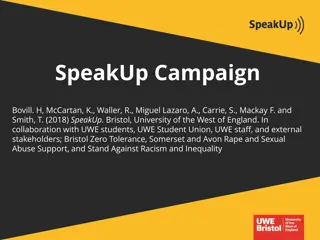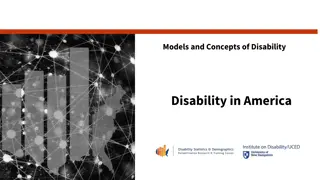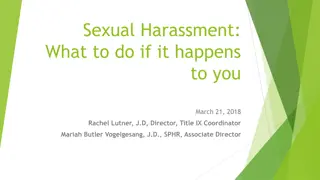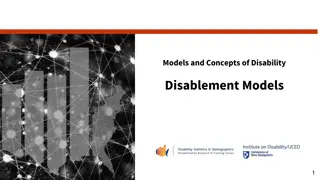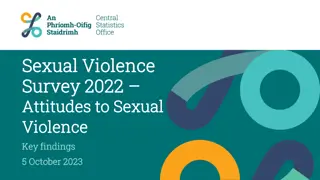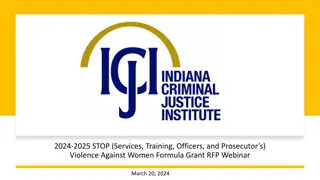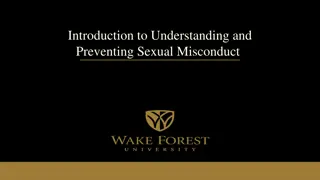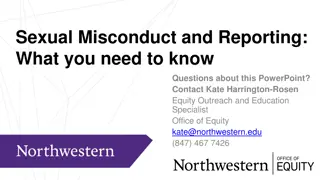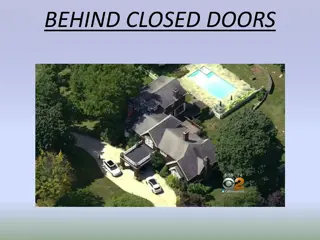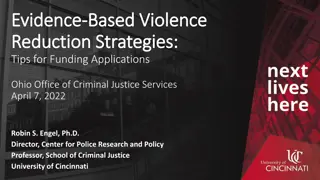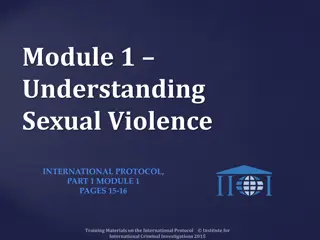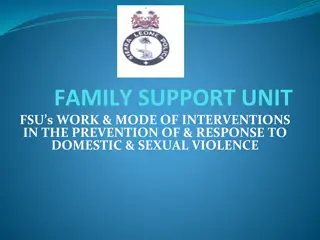Understanding the Intersection of Sexual Violence and Disability
This presentation sheds light on the alarming rates of sexual violence against individuals with disabilities, highlighting the prevalence of abuse and victimization. It aims to challenge personal biases, dissect root causes, and identify sources of ableism and oppression. Participants will gain foundational knowledge to promote equity, inclusivity, and address this critical issue.
Download Presentation

Please find below an Image/Link to download the presentation.
The content on the website is provided AS IS for your information and personal use only. It may not be sold, licensed, or shared on other websites without obtaining consent from the author. Download presentation by click this link. If you encounter any issues during the download, it is possible that the publisher has removed the file from their server.
E N D
Presentation Transcript
The Intersection of Sexual Violence & Disability Liz Poprocki, MA, RAAS, CA Owner Equitology Consulting, LLC
GOALS GOALS Obtain foundational knowledge of epidemic of sexual violence against persons with disabilities Challenge and address your own personal biases Dissect the root causes of sexual violence against persons with disabilities Identify sources of ableism and oppression Leave with a new lens with which to practice equity and inclusivity
Content Warning This presentation will include readings, media, and discussion about the sexual assault, physical violence, and identity-based discrimination of disabled persons. This content can be difficult to hear so you are encouraged to care for your safety and well-being.
70% of people with disabilities surveyed (+2,000) reported that they had been victims of abuse (The Disability & Abuse Project, 2013) More than 63% of their family members said their loved one with a disability had been a victim of abuse (The Disability & Abuse Project, 2013) In 2015, the rate of violent victimization (rape, robbery, aggravated assault) against persons with disabilities was more than 3 times higher than for persons without disabilities (Harrell, 2017) During 2011-2015, persons with cognitive disabilities had the highest rates of total violent crime (57.9 per 1,000 people) (Harrell, 2017) People with multiple disabilities were victims at a rate three times higher than people with a single disability (Harrell, 2017) 65% of rapes against persons with disabilities were committed against those with multiple disabilities the HIGHEST percentage among all violent crime types (Harrell, 2017) JUST THE NUMBERS
In 2018, NPR discovered unpublished data from the Bureau of Justice Statistics that showed that persons with disabilities are sexually assaulted at a rate 7 times that of neurotypical persons.
SEXUAL VIOLENCE AGAINST DISABLED MEN The rate of violent victimization against males with disabilities was 31.8 per 1,000 persons compared to 14.1 per 1,000 for males without disabilities The prevalence of lifetime sexual violence is 14% among disabled men compared to the 4% among men without disabilities Men with cognitive disabilities might not know if they are victims of sexual violence because of the stigma surrounding all men, neurodiverse and neurotypical, and sexual violence
For as long as I can remember society has had the idea that men do not show emotion. We are told to be strong, not to cry or share feelings. These ideas are communicated from an early age. The expectations of manhood are very high and never include opening up about any type of abuse, especially sexual assault and violence perpetrated against them, as an adult or a child. Men with disabilities face an even more difficult hurdle of not being believed or seen as credible when they do report because they have a disability, and can be even more difficult for those who are LGBTQ, who are at greater risk due to their sexual orientation. Those in authority have looked the other way when we have disclosed. When disclosure happens we are not asked how we feel. For those that are not able to tell, they act out their fear in frustration and then are medicated and the abuse continues. Many of us do not believe there will be any consequences even if we do tell. This is a deep-reaching issue that we must deal with to have a healthy, inclusive, and safer society. Every sexual assault survivor needs to know they matter, are respected, and can be safe. Chris Miller, Survivor
Statistical Biases Statistics based on the non-institutionalized population Data on crimes committed against persons with disabilities is limited This data is based on people 12 years old and older (Harrell, 2017) It does not consider trans-men and trans-women with disabilities Does not include mental illness Lack of comprehensive data Not based on data from states Only based on those crimes reported Only based on those disabilities disclosed PROBLEMS WITH THIS DATA
I felt dirty. I just felt not clean. I blamed myself. And I felt powerless. I couldn t even look in the mirror, because you see, all that comes back to you. It just does. In Their Own Words Debbie Robinson, Survivor Picture and quote from NPR expos , In Their Own Words: People with Intellectual Disabilities Talk About Rape
40 million Americans live with a disability 14% of the population age 12 or older living outside of institutions have a disability (U.S. Census Bureau ACS, 2011-2015) 42% of the population with disabilities were age 65 or older (U.S. Census Bureau ACS, 2011- 2015) DISABILITY POPULATION IN THE U.S.
DISABILITY UNDER THE ADA In the context of the ADA, disability is a legal term rather than a medical one. Because of this, the ADA s definition is different than how disability is defined under other laws like Social Security Disability related laws. The ADA is a federal act that requires your organizations to provide accommodations and non-discriminatory services hence why we are using this definition today it directly impacts you! The ADA defines a person with a disability as a person who has a physical or mental impairment that substantially limits one or more major life activity. This includes people who have had a record of such an impairment even if they do not currently have a disability. It also includes individuals who do not have a disability but are regarded as having a disability. (https://adata.org/faq/can-you-give-me-example-someone-who-regarded- having-disability)
Hitting Kicked Punched Pinched Tripped Restraint Isolation Harming of service animal Destroying assistive technology Ignoring safety requirements Using equipment to harm the person PHYSICAL ABUSE
MEDICAL OR PHYSICAL NEGLECT Over or under medicating Not enough food and/or drink Withholding care Unsafe environment Withholding access to assistive technology, service animals, medical equipment Not carrying out treatment plan Using abuse as behavior management
Blaming Shaming Humiliating and Ridiculing Intimidation Coercion Threatening Using the person s disability against them Ignoring requests Minimize, justify, and blame EMOTIONAL ABUSE
Financial exploitation Financial scams Theft by guardians Stealing survivor s belongings Selling survivor s belongings Identity theft Social security theft Limiting access to funds THEFT & FRAUD
SEXUAL ABUSE & ASSAULT When speaking about sexual assault against persons with disabilities, the term abuse is used most often. Even in our language, we are not being equitable. Penetration, touching, voyeurism, coercion, rape Power and control All of the other tactics of victimization are used to sexually assault a person with a disability and to keep them from reporting
I took a liking to him. I spent the most time with him and taught him how to brush his teeth, tie his sneakers and even ride a bike. I would often take him for [shoulder] rides, at his request, and carry him around the residence. I could have stayed in that house for years and abused him every day without anybody noticing at all. It was a predator s dream. Stephen DeProspero Currently serving 40 years in prison for filming himself sexually assaulting a disabled 10 year old boy he cared for at a state institution in New York
40% committed by persons the victims knew well or who were casual acquaintances Transportation Caregivers Service Providers 30% committed by strangers 15% committed by significant others 10% committed by family members 5% unknown (U.S. Dept. of Justice, 2016) OFFENDERS
Perpetrators against persons with disabilities do so from the framework that the individual is the problem. Their disability makes them vulnerable. This way of thinking is victim-blaming, ableist, and holds the victim responsible for their own victimization.
WHY VICTIMIZE A DISABLED PERSON?
POLLING Participants will use Poll Everywhere to enter their answers to Why victimize a disabled person? This question aims to put the participant in the shoes of the perpetrator.
I dont want to say easy target, but it is an easy target, because people try to work so hard to try to find friends and try to fit in our community. James Meadours, Survivor and Activist Picture and quote from NPR expos , In Their Own Words: People With Intellectual In Their Own Words Disabilities Talk About Rape
WHAT ARE THE BARRIERS TO REPORTING?
POLLING Participants will use Poll Everywhere to answer the question, What are the barriers to reporting? This question aims to place the participant in the shoes of the victim with the disability.
BARRIERS TO REPORTING Physical, Attitudinal, and Programmatic inaccessibility to services Lack of access to assistive technology Lack of universal design Caregivers and family members Limited knowledge of supports or advocacy services Service provider biases/survivor s biases Coercion to not disclose or seek help Inaccessible systems BARRIERS COME FROM ABLEISM
Their disability Taught to obey Communication limitations Reliance on caregivers Isolation in homes and residential facilities Seen as not credible or reliable No sex education or healthy relationships WHAT ARE PERCEIVED VULNERABILITIES ? Perceived vulnerabilities are taught to the individual with the disability. They are vulnerabilities learned from a society that is inaccessible and unwilling to meet their needs. They are a form of ableism.
We are taught to trust grown-ups more than anyone else would be. Because when you have a disability, people are always telling you, Do as that person says , Do as this person says. IN THEIR OWN WORDS Thomas Mangrum, Survivor Picture and quote from NPR expos , In Their Own Words: People with Intellectual Disabilities Talk About Rape
HISTORICAL & SOCIETAL OPPRESSION Greek and Roman empires Obsessed with beauty. Believed beauty and intelligence were intertwined. Believed successful communication was the key to learning. No word existed for disabled . Having a disability meant god hated you. Disabled children were killed or left for dead. Middle Ages People with disabilities were outcasts, considered evil and cursed by God. Institutions were first developed and the conditions were less than humane. Renaissance Institutionalization continued. People with disabilities were used as court jesters and entertainment. The first psychiatric hospital was built. 1700s Continued institutionalization, eugenics, test subjects, segregation, homicides, and sent to be with the circus. 1800s Poorhouses built to remove persons with disabilities from the streets. Eugenics continued. 1900s Continued to be test subjects, institutionalized and segregated. Persons with disabilities were not allowed to enter the United States. Sent to be with the circus. Continued eugenics.
Ableism is the discrimination of and social prejudice against people with disabilities based on the belief that neurotypical abilities are superior. Ableism classifies an entire group of people as less than Ableist views and beliefs are at the core of why persons with disabilities continue to be sexually assaulted. Internalized Ableism Beliefs that being able- bodied or able-minded is preferable. It can be weaponized toward yourself or toward other disabled people through modifying, shaming, or policing your own behaviors and actions to appear more abled . ABLEISM WHAT IS IT?
A system that places value on peoples bodies and minds based on socially constructed ideas of normalcy, intelligence, and excellence. These constructed ideas are rooted in anti- Blackness, eugenics and capitalism. This form of systemic oppression leads to people and society determining who is valuable or worthy based on people s appearance and/or their ability to satisfactorily produce, excel, and behave. A working definition by Talila TL Lewis
Thats so lame. You re retarded. That guy is crazy. You re so bipolar today. Are you off your meds? It s like the blind leading the blind. My ideas fell on deaf ears. She s a psycho! I m super OCD about how I clean. Oh my God that totally gave me a panic attack! Can I pray for you? I don t even think of you as disabled. ABLEIST LANGUAGE
Physical barriers such as lack of ramps, elevators, no sidewalks, no push- buttons for doors, lack of accessible transit Poorly designed rooms, narrow doorways, door knobs that are hard to open Story lines that include disabled characters written to be angry, difficult, or used for inspiration porn Not disclosing a disability for fear of not being hired Talking to a person with a disability like a child Erasure of disability rights history or disability pride movements Assuming people have to have a visible disability to be disabled Restraint and seclusion against people with disabilities Questioning if someone is actually disabled or how much are they disabled Lack of accessible housing Marriage inequality (loss of benefits if they marry) Financial constraints (will lose their much needed benefits if they work) Unequal pay ABLEISM IN DAILY LIFE (to name a few)
Inaccessible advocacy organizations (physical, attitudinal, and programmatic) Inaccessible hospital examinations and advocacy services Service providers don t understand the Americans with Disabilities Act Persons with disabilities aren t being taught about sexual health and healthy relationships Minimizing and ignoring the impairment and how traumas affect disabilities The medical model is used the most in addressing sexual violence against persons with disabilities Harmful biases and beliefs from service providers and allied professionals Ableism dictates what kinds of services survivors with disabilities can receive Harmful and destructive language Not acknowledging the survivor s cultural differences as a disabled person Survivor rights not being upheld or exercised because of ableism Lack of training and education around safety planning Trusting service providers and caregivers too much Not listening to the person living with the disability and instead believing the neurotypical appearing person ABLEISM IN THE ANTI- SEXUAL VIOLENCE MOVEMENT
A denial of the ability to be sexual. Sexual ableism defines how bodies experience oversight and regulation of sexual and reproductive behaviors. Supports the notion that persons with disabilities are not fit to marry, have children, or enjoy sex therefore they are not educated on how to have safe consensual sex and healthy relationships Support the idea that persons with disabilities, specifically intellectual disabilities, are not sexual beings Prevention specialists need to be concerned about sexual ableism SEXUAL ABLEISM
Violence is a mechanism by which individuals assert ableism Violent ableism encompasses deprivation of health through personal violence (direct violence) and social injustice (structural violence). ( Violent Ableism: A Structural Epidemic , 2019) Broad assumptions about persons with disabilities dehumanize them and therefore increase their vulnerability to violence Structural violence breeds violent ableism through personal and direct violence like sexual assault. VIOLENT ABLEISM
Ableism is a deep-rooted belief that persons with disabilities are far less important than neurotypical people. Ableism seeks to continuously keep disabled persons disenfranchised and suffering. Offenders use the tactics of power and control influenced by ableism to rape persons with disabilities Our advocacy systems continue to utilize ableist views, beliefs, programming and services which stagnates the anti-sexual violence movement Barriers and perceived vulnerabilities contribute to violent ableism. ABLEISM AND SEXUAL VIOLENCE
POLLING Participants will be using Poll Everywhere to anonymously share their experiences with ableism. Participants will be prompted to share how they have participated in ableism, how their organization participates in ableism, and how others have experienced their ableism.
Ableism Ableism set the stage for: mentally disabled, mentally ill, sexually deviant, and unfit Communities of color Communities of color to be understood as less capable, smart or intelligent, therefore a natural fit for slave labor Women s bodies Women s bodies to produce children when, where, and how men needed them People with disabilities People with disabilities to be seen as disposable in a capitalist and exploitive culture because we are not seen as productive Queer and trans people Queer and trans people to be institutionalized as must cure because it is weakening our country Violence, cycles of poverty, lack of resources, and Violence, cycles of poverty, lack of resources, and war war to be used as systemic tools to construct disability in communities and entire countries Immigrants Immigrants to be thought of as a disease that we By Mia Mingus
TIPS FOR COMBATING ABLEISM Believe people when they disclose a disability Listen to people when they request an accommodation Don t assume you know what someone needs Don t speak on behalf of someone with a disability unless asked to Talk about disabilities Call in and call out ableism Incorporate anti-ableism and accessibility into your awareness, programs, and organization Make sure people with disabilities are at the table when decisions about them are being made www.accessliving.org/newsroom/blog/ableism-101/
In the next module, we will be discussing how to serve survivors of sexual violence with disabilities. Understanding ableism is a key component to being able to competently serve these survivors so that your services are equitable and accessible. In the third and final module, we will be discussing how your organization can become more accessible in serving survivors with disabilities. The concepts learned today will influence your ability to competently design and implement accessible and equitable services for survivors with disabilities that combat ableism. HOW TO APPLY THIS INFORMATION
Liz Poprocki, MA, RAAS, CA Owner Equitology Consulting, LLC equitologyconsulting@gmail.com



